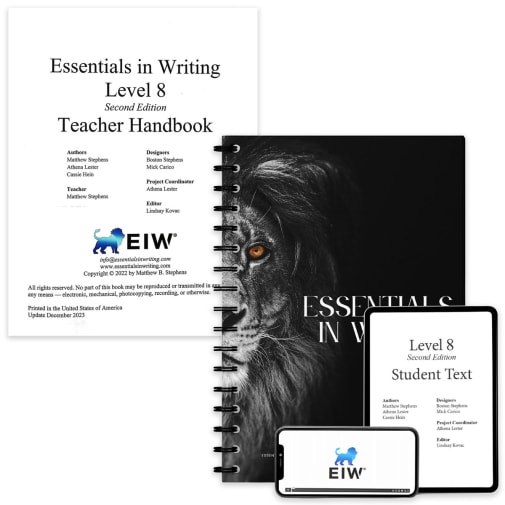Level 8 Bundle with Online Video Subscription includes print Textbook, Teacher Handbook, and access to online video and the online Textbook/Teacher Handbook. This set includes everything needed for the course, except for assessments. The books will be shipped with your order, and information on accessing the online video will be emailed to you by Essentials in Writing within 1-3 business days.
Essentials in Writing Level 8 Bundle (Textbook, Teacher Handbook and Online Video Access) 2nd Edition
Product Overview
- This product includes content identical to the books with new lion cover
- Extra workbooks and assessments available for additional students
- Purchase a bundle for the complete course (with Teacher Handbook and video instruction)
Description
This homeschool writing curriculum features a slow, systematic approach for eighth grade students, aged 13 to 14, to learn to write well. The step-by-step approach allows students to focus on small, daily assignments, so they don't feel overwhelmed and retain the information.
Homeschool students will learn to apply parts of speech and different sentence structures as well as use them as tools for effective communication. They will address common problems in writing, including sentence errors, pronouns and antecedents, subject/verb agreement, homophones, unclear subjects, paraphrasing, and summarizing. They will practice crafting compositions including paragraphs, a narrative, a business letter, essays, and a research project. Students will explore expository, descriptive, persuasive, compare, and contrast writing.
Includes: Printed Textbook, Printed Teacher Handbook, Online Textbook, Online Teacher Handbook, and Online Video Subscription. The 12-month online video lesson access comes with free renewals, free customer service and teacher support.
This 2nd edition provides the same solid instruction as the first edition, but with significantly expanded content (over 120 pages of new material) and updated video teaching. Courses require the student workbook, the included online instructional video, teacher handbook, and an optional assessment resource. Online access is initiated with an email from the publisher to set up an account and includes video lessons, PDF textbooks, and Teacher Handbooks. Another distinctive is the spiral teaching approach: a key element in developing writing skills. From year to year, you'll see repeated concepts and tasks, but exercises will differ and build in difficulty.
Unit 1 helps students apply proper grammar and word choice: selecting words with skill. Unit 2 begins the composition instruction focusing on 5 styles (expository, persuasive, descriptive, compare, and contrast). For each of these writing types, 3 lessons progressively teach through key brainstorming steps; organizing and drafting; and revising and final drafting. Then, lessons 41-78 move to learning various essay methods, applying previously learned skills while learning new skills tailored toward specific purposes: Narrative, Expository, Compare/contrast, and Persuasive writing. The year culminates in a research project with 15 lessons specifically guiding students through key researching steps such as summarizing, paraphrasing, taking notes and sourcing material. Instruction requires that students create source cards for bibliography and notetaking. (A side note: when I taught research writing, I loved this technique as a tangible tool. As an 8th grader, not so much—but it was good for me.) Twelve, blank, preprinted source cards are included at the back of each student text (additional copies in the Assessment Resource). Included in combo kits, the updated lesson Video Instruction (12-month online access) creates the sense of a one-on-one tutorial with instructor Matthew B Stephens, who guides students through assignments, modeling steps, and applications. The engaging videos help make skill acquisition and writing tasks significantly more palatable.
Most lessons are spread out over 2 days. When introduced to a new skill, your student receives descriptions and definitions, examples, graphic organizers, word banks, and the like. Students will work through steps and then complete a draft on separate paper. Each writing assignment includes formatting rules, directions for editing, a comprehensive project checklist, and a detailed rubric for each composition assignment. Rubrics are my favorite way to grade compositions, assigning a point value to measure skill levels in specific areas. For example, the directions state to give your student 8 points if the word choice and sentence structure is rich and varied. Give 2 points if it is basic, lacking variety. If students choose to revise, or when students begin the next assignment, they have tangible information to improve their writing skills, style, and content.
The page layout significantly improves legibility: well-organized typesetting, just-right-amount of color accents; and bolded instructions. Grading is recorded right in the textbook using a point system. While the typesetting (16-point font) is a perfect size and legible in instruction, some students might initially struggle with the italic font (used in sample sentences, paragraphs, and the like).
The Assessment Resource book provides 20 assessments, 2 comprehensive unit tests, and additional resources, organizers, and research cards. The Teacher Handbook provides a quick explanation of the course, possible course schedules, answers for all questions (in 8 pt font) and includes sample responses to assignments.
Items are sold as a bundle (textbook, teacher handbook, and online video subscription, with additional online textbook/workbook/teacher handbook available free); the bundle with the Assessment Resource Book; individual Assessment Resource Books; and individual Additional Student Workbooks. Note: any products which are digital download are nonreturnable. Printed in the USA.
| Product Format: | Other |
|---|---|
| Grade: | 8 |
| Brand: | Essentials in Writing |
| Length in Inches: | 11 |
| Width in Inches: | 9 |
| Height in Inches: | 0.75 |
| Weight in Pounds: | 1.2 |

